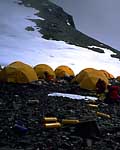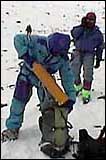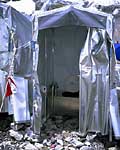
Wally Berg
| Daily Dispatches Satellite phone updates from the 1998 American Everest Expedition CLICK FOR COMPLETE INDEX OF DISPATCHES |
 Wally Berg |
|
| Hear Wally Berg's call from Base Camp Click for [RealAudio] or [NetShow] |
| Satellite phones for Everest cybercasts provided by MVS/USA | |
 Camp IV on the South Col is pitched amongst climbing debris from the past [click to zoom] (photo: Corfield) |
One thing that is probably, saying right off the bat, this year is that of the three American expeditions that are on the mountain, ours is the only one that is not expressly and by name an environmental expedition, interestingly enough. The other two American teams are comprised, at least partly, by characters that are old associates and friends of mine from climbing around the world and specifically here on Everest. One team has Tom Whittaker on it who I was with on Everest here in 1989 in his first attempt. It also has old, dear friends, Jeff and Kelly Rhodes on that team. Then the Bob Hoffman team has some characters that I climbed with back in 1992 on Everest, old dear friends, and certainly a pleasure to be back here on the mountain with them. Those teams have undertaken to be specifically environmental by name as I said.
We've had some talks about what we're going to do this year, and it always leads to interesting situations. It's been on my mind a lot on just what the public should know, the mountaineer public, who is so interested in this, what they should know about the efforts that are ongoing to clean up Everest. Specifically, my involvement this year, even though we don't have the environmental name, is that I'm continuing a program that came to me through Brent Bishop that has been funded by Nike over the last few years. I believe this will be the fourth consecutive year we've had this program underway, the second consecutive year I've conducted it on the mountain.
 Sherpas pack empty oxygen bottles to carry down from the South Col [click to zoom] (photo: Lakpa Rita) |
There is sort of the obligatory pile of oxygen bottles that everyone takes a photograph of, a great deal of concern about these. There has been a program underway to pay Sherpas who have already carried to the Col to bring these empty bottles back down. We pay pretty generously for them, delivered back to base camp and then Nike pays for them to be transported via yak and helicopter back to Kathmandu as well. It's a good program, seen a lot of results. Last year, all the Russian bottles were gone. They have sort of a double value besides being small and easy for the Sherpas to carry down for the buy-back program, they also have about a $40 resale value, the Poisk do, in Kathmandu to be shipped back and refilled in Russia. You know, there is an incentive to get these bottles down, and they have been coming down and we're going to continue the program this year.
 The area where climbing debris is mostly concentrated [click to zoom] (photo: Burleson) |
I've specifically described in the two years I've conducted this program that I do not feel that bringing oxygen bottles off the South Col is an environmental concern or an environmental issue. It's, honestly, an aesthetic issue, probably only a western aesthetic issue, in that that type of clutter, if you will, bothers many of us western people who value mountains and hold them special. Yet honestly, if you talk to Sherpas, it has not ever struck them that way, but we've had this program going to bring these bottles down.
Moving on to what is a bigger concern is trash. Our team won't be involved; the two teams that have environmental focus will be involved with cleaning up trash at Camp II — an admirable and necessary, worth-while goal. Of course, all teams are required by the SPCC(Sagarmatha Pollution Control Commission), and it's reiterated by the Ministry of Tourism in Nepal to bring their own trash off the mountain, and we have been doing that in recent years and we will continue to this year. I'm talking about the excess trash that has been left up there. These other teams are going to do good work to bring that down this year.
 The much wondered about bathroom in base camp [click to zoom] (photo: Corfield) |
In particular, I'll go ahead and delve into the more unpleasant topic because it certainly affects health, and it's very important with regards to removal of human waste, feces. The SPCC has had a requirement for a few years that is enforced and is in effect that solid human waste goes into barrels, what we classically just call "expedition barrels." We put toilet seats on top of them, and it is removed by porter from the moraine here at base camp.
 "This is your water supply. Do not use this place as a toilet." [click to zoom] (photo: Corfield) |
So a little description for those who care to listen about the efforts underway, and the reality of what's been going on here which is in fact that a great deal of influence has been exhorted to climbers coming to this base camp by the government of Nepal to adhere to an ethic of keeping the mountain clean. I'm happy to report to those who are interested in this that it's been a great deal of good success and a lot of good has happened. Of course, teams are still showing up here expressly to improve the situation more and we intend to support them fully in that. So, all three American teams in their own way are contributing this year. I have the oxygen bottle buy-back, and we have two teams that are expressly committed to leaving this mountain a cleaner place than they found it. Take care.
— Wally Berg, Expedition Leader
| DISPATCHES | |
|
|
More, more, more...